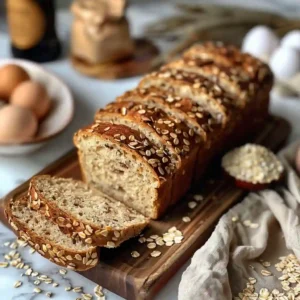Struggling with mood swings, fatigue, or hormonal imbalances and suspect histamine could be part of the problem? You’re not alone—and you’re in the right place. Low histamine bread isn’t just another wellness trend. It’s a thoughtful shift toward supporting your body’s natural rhythms with every slice.
In today’s fast-paced world, processed food and high-histamine ingredients sneak into our diets more than we realize. That used to be a big problem in my house. As a busy dad trying to get dinner on the table while juggling the chaos of family life, I started noticing that certain foods seemed to trigger my wife’s headaches and left me feeling sluggish. Bread—our everyday staple—was a hidden culprit.
So, I decided to take matters into my own hands and bake a better loaf. One that’s simple, nourishing, and crafted with safe, low-histamine ingredients that align with natural hormone balance. Through trial, error, and plenty of kitchen experiments, I found a winning formula: low histamine bread that actually supports our health goals instead of working against them.
This guide breaks down everything you need to know about baking or buying low histamine bread, how it can affect your hormones, what ingredients to avoid, and which ones to trust. We’ll also tackle top FAQs like whether Ezekiel or sourdough bread is a safe choice, and even touch on great pairings like low histamine salad dressings that complement your loaf without causing flare-ups.
What surprised me most was how easy it became to make better food decisions once we started using low histamine bread regularly. It helped stabilize our energy, improved digestion, and gave us confidence that we were making smarter, body-friendly choices.
Let’s dig into Part 1: the connection between histamine and hormones—so you can start making more empowered food choices today with the help of low histamine bread that works with your body, not against it.
Table of Contents
Understanding Histamine and Hormone Balance
What is Histamine and How It Works in the Body
Histamine is a natural chemical involved in several important bodily functions—like digestion, immune response, and even brain function. But when levels rise too high, often due to food triggers, the body can experience symptoms like headaches, bloating, anxiety, fatigue, or skin irritation.
Normally, enzymes like DAO (diamine oxidase) help break down histamine, but if those enzymes aren’t functioning properly or your diet is overloaded with high-histamine foods, histamine can build up. That buildup can stress your system—especially your hormones.
How Histamine Affects Hormone Regulation
Histamine isn’t just about allergies—it plays a surprising role in hormonal balance. For example:
- Estrogen stimulates histamine release
- Histamine increases estrogen production
This creates a loop that can make symptoms like PMS, anxiety, and migraines worse.
That’s why for many women—and even men—managing histamine through food helps reduce estrogen dominance and hormonal imbalances. Lowering histamine can calm inflammation and support more stable energy, moods, and menstrual cycles.
So if you’re feeling foggy or edgy and don’t know why, the bread on your plate might be quietly contributing.
Why Bread Matters in a Low Histamine Diet
Bread is a comfort food in nearly every home, but traditional store-bought loaves can be a histamine bomb. Ingredients like yeast, vinegar, aged flour, or preservatives can spark reactions or worsen hormonal issues in sensitive individuals.
That’s where Low Histamine Bread changes everything.
I used to grab “healthy” sprouted loaves without thinking twice—until I realized they were loaded with histamine-triggers. After switching to homemade, clean-ingredient options like Low Histamine Bread, the changes were remarkable: clearer skin, better sleep, fewer mood swings.
Unlike heavily processed breads, Low Histamine Bread is made with carefully selected ingredients that won’t disrupt your hormones. It’s not just about managing symptoms—it’s about reclaiming your energy, mood, and clarity with each bite.
Low Histamine Bread can offer more than relief. It can be a daily anchor for balanced energy and hormone health—without sacrificing taste or texture.
In the next part, we’ll unpack the specific ingredients to avoid when choosing or making your own Low Histamine Bread.
Ingredients to Avoid in Bread for Hormone and Histamine Health
Common Bread Ingredients That Are High in Histamine
Many popular bread ingredients sound innocent—until you’re dealing with histamine intolerance. From my experience, these were the biggest triggers that caused bloating, irritability, and brain fog in my home:
- Yeast (baker’s or brewer’s) – a fermentation agent that’s naturally high in histamine
- Vinegar – found in some sourdough and flavoring agents
- Fermented grains or flours – aged or processed grains raise histamine levels
- Citrus-based dough conditioners – these are hidden in many mass-market breads
- Aged or long-proofed doughs – while great for texture, they often spike histamine
- Soy flour or soy lecithin – often used in commercial bread to increase shelf life
Even “whole grain” and “organic” breads can include these red-flag ingredients if you’re not reading the label closely. That’s why switching to low histamine bread was such a game-changer in our home—it removed all of these mystery triggers in one move.
Preservatives and Additives That Disrupt Hormones
Aside from histamine overload, many store-bought breads also sneak in preservatives and additives that can throw your hormones out of sync. Some of the biggest offenders I learned to spot and avoid:
- Calcium propionate – a common preservative linked to behavioral issues
- BHA/BHT – often used to prevent spoilage but may act as endocrine disruptors
- Dough conditioners (like azodicarbonamide) – banned in some countries due to health risks
- Artificial sweeteners or corn syrup – these spike insulin, disrupt cortisol, and stress your system
Once I started cutting these out and baking low histamine bread from scratch, I noticed fewer mood dips, more energy, and less irritation after meals. For anyone navigating hormone-related health concerns, these small adjustments add up.
Why Fresh, Clean Ingredients Are Essential
If you’re baking or buying low histamine bread, freshness matters more than you might think. Ingredients should be as close to whole, unprocessed form as possible. That means:
- Organic or fresh-milled flours
- Filtered water
- Cold-pressed oils
- Simple leavening like baking soda or psyllium
- Minimal (or no) salt and absolutely no citric acid
With low histamine bread for hormone balance, the goal is simple: feed your body in a way that calms inflammation, not fuels it. Clean ingredients give your system a break—and your hormones room to breathe.
Best Ingredients for Low Histamine Bread for Hormone Balance (Optimized)
Low Histamine Flours That Support Hormonal Health
When I first started baking low histamine bread, finding the right flour was the hardest part. Many traditional options like wheat and rye were off the table. Through testing and researching, I discovered several flours that worked beautifully—and didn’t trigger histamine flare-ups or hormone disruptions:
- White rice flour – naturally low histamine and light in texture
- Tapioca flour – adds chewiness without the allergens
- Millet flour – gluten-free, mild, and good for estrogen balance
- Quinoa flour – high in protein and supportive of blood sugar stability
- Sorghum flour – rich in nutrients, gentle on the gut
- Coconut flour – low carb and good for cortisol regulation
These flours not only avoid histamine build-up, they also support key hormone functions by stabilizing blood sugar, reducing inflammation, and easing digestion. When combined thoughtfully, they create a strong foundation for low histamine bread that’s light, moist, and nourishing.
Histamine-Friendly Binders and Moisture Boosters
Most traditional breads use eggs, dairy, or yeast as binders—but for histamine-sensitive folks, those can be risky. Here’s what I use instead:
- Ground flax or chia seeds – mix with water to create a gel-like binder
- Psyllium husk – fantastic for texture and gut-friendly fiber
- Olive oil or avocado oil – heart-healthy fats that won’t trigger histamine
- Unsweetened applesauce – natural sweetness and softness in baked goods
- Zucchini or pumpkin puree – adds moisture and minerals without histamine triggers
These ingredients not only help hold your bread together, but they also gently support hormone balance by fueling your metabolism and reducing stress on the gut-liver axis. And when they’re baked into a base of clean, anti-inflammatory flours, you get low histamine bread that feels good in every bite.
Safe Leavening Options for Low Histamine Bread
Yeast is a hard “no” when you’re keeping histamine low. But that doesn’t mean your bread has to be flat or dense. Here are safe, histamine-friendly leavening choices I trust:
- Aluminum-free baking powder – lightens your bread without inflammation
- Baking soda + acid combo – like lemon juice or cream of tartar (in small amounts)
- Sourdough with young fermentation – use cautiously if tolerated, under 4 hours
Remember, the longer a dough sits and ferments, the more histamine it produces. That’s why a fast-rise, yeast-free recipe is your best bet for clean low histamine bread that won’t cause hormone chaos.
Whether you’re baking from scratch or adapting an existing recipe, choosing the right ingredients is the secret to success. It’s how I turned frustrating meals into reliable, hormone-supportive staples—and why I keep going back to low histamine bread as a foundation of our weekly menu.
Best Store-Bought Low Histamine Bread Options (and What to Watch Out For)
What to Look for on Bread Labels
When I first started this low histamine bread journey, shopping for the right loaf felt overwhelming. But with a little practice, reading labels became second nature. Here’s what I always scan for first:
- No yeast or sourdough cultures
- No vinegar, malt, or fermented ingredients
- No “natural flavors” or citric acid (often hidden histamine triggers)
- Simple ingredient list – fewer than 10 ingredients is ideal
- Preservative-free – avoid calcium propionate, BHA/BHT
- No dairy, soy, or eggs if you’re extra sensitive
The best low histamine bread brands are upfront about being allergen-friendly, and often market themselves as gluten-free or anti-inflammatory. But be careful—gluten-free doesn’t always mean low histamine.
Safe Low Histamine Bread Brands (Based on Experience)
While not all store-bought bread is safe, here are a few brands I’ve found that are more likely to be tolerated—though personal sensitivity varies:
| Brand Name | Notes on Safety |
|---|---|
| Simple Kneads | Yeast-free, gluten-free, clean ingredients |
| Unbun | Grain-free, low carb, minimal additives |
| AWG Bakery | Made for autoimmune and histamine-sensitive diets |
| Local artisanal gluten-free bakeries | Check ingredients and fermentation time |
No matter which low histamine bread you choose, always refrigerate or freeze it upon purchase to limit histamine buildup during storage. I’ve made this a habit at home, and it’s made a noticeable difference.
Popular Breads to Avoid
Some breads look healthy but are loaded with histamine triggers. Based on my own symptoms and community feedback, I avoid:
- Dave’s Killer Bread – sprouted grains, high fermentation
- Ezekiel Bread – made with live grains and fermentation
- Sourdough (store-bought) – long fermentation = high histamine
- Rye or whole wheat – hard to digest and more likely to trigger hormonal symptoms
- Anything “aged,” “cultured,” or “fermented” on the label
If you’re just starting out, stick to trusted brands or better yet, try making your own low histamine bread at home. It’s easier than you think and gives you total control over ingredients and freshness.
In the next part, I’ll walk you through my go-to homemade low histamine bread recipe—a family favorite that keeps our hormones (and taste buds) in balance.
Print
Low Histamine Bread for Hormone Balance: Safe Ingredients & Recipe Guide
A hormone-friendly, low histamine bread that’s yeast-free, clean, and perfect for sensitive bodies and picky eaters alike.
- Total Time: 1 hour
- Yield: 1 loaf
Ingredients
- 1 cup millet flour
- 1/2 cup white rice flour
- 1/2 cup sorghum flour
- 1/4 cup tapioca flour
- 1 tbsp psyllium husk powder
- 1 tbsp ground flaxseed (or chia seeds)
- 1 tsp baking soda
- 1 tbsp lemon juice (or cream of tartar for lower acid)
- 1/4 tsp sea salt
- 1 1/4 cups filtered water
- 2 tbsp avocado oil or olive oil
Instructions
- Preheat your oven to 350°F (175°C). Line a loaf pan with parchment paper.
- In a large bowl, combine all dry ingredients.
- In a separate bowl, mix water, lemon juice, and oil.
- Slowly pour wet mixture into dry and stir until thick and doughy.
- Transfer into loaf pan, smoothing the top.
- Bake for 45–50 minutes, or until a toothpick comes out clean.
- Let cool completely before slicing (this helps texture and digestion).
Notes
This bread keeps well in the fridge for up to 4 days or freeze in slices for longer storage—this is key for minimizing histamine buildup.
- Prep Time: 10 minutes
- Cook Time: 50 minutes
- Category: Bread
- Method: Baking
- Cuisine: Healthy
Homemade Low Histamine Bread Recipe for Hormone Balance
Why Bake It Yourself?
If you’re serious about supporting your hormone health while managing histamine levels, baking your own low histamine bread is hands-down the most reliable path. That’s how I started. I couldn’t trust what was on the shelf anymore, so I rolled up my sleeves and got to work.
Baking from scratch gives you total control over:
- The freshness of ingredients (key for keeping histamine low)
- Avoiding additives or hidden triggers
- Tailoring the recipe to your taste and needs
This recipe has become a staple in my kitchen. It’s easy, flexible, and gets the thumbs-up from picky kids and hormone-sensitive adults alike.
Low Histamine Bread Recipe (Yeast-Free & Hormone-Friendly)
Here’s my simple, go-to low histamine bread recipe that checks every box—histamine-safe, hormone-friendly, and delicious.
Ingredients:
- 1 cup millet flour
- 1/2 cup white rice flour
- 1/2 cup sorghum flour
- 1/4 cup tapioca flour
- 1 tbsp psyllium husk powder
- 1 tbsp ground flaxseed (or chia seeds)
- 1 tsp baking soda
- 1 tbsp lemon juice (or cream of tartar for lower acid)
- 1/4 tsp sea salt
- 1 1/4 cups filtered water
- 2 tbsp avocado oil or olive oil
Instructions:
- Preheat your oven to 350°F (175°C). Line a loaf pan with parchment paper.
- In a large bowl, combine all dry ingredients.
- In a separate bowl, mix water, lemon juice, and oil.
- Slowly pour wet mixture into dry and stir until thick and doughy.
- Transfer into loaf pan, smoothing the top.
- Bake for 45–50 minutes, or until a toothpick comes out clean.
- Let cool completely before slicing (this helps texture and digestion).
Once cooled, this low histamine bread keeps well in the fridge for up to 4 days. You can also freeze individual slices for longer storage—this is key to minimizing histamine buildup and keeping your hormone goals on track.
Nutrition & Hormonal Benefits Snapshot
This bread isn’t just about what it leaves out—it’s about what it offers. Whole grain flours like millet and sorghum provide gentle fiber. Healthy fats from olive oil support hormone production. And by avoiding yeast, you lower your risk of histamine spikes that can throw everything off.
Storing and Handling Low Histamine Bread Safely
Why Storage Matters for Histamine Levels
When it comes to low histamine bread, how you store it is just as important as how you bake it. Histamine builds up in food over time—even if it starts out low. That means yesterday’s safe loaf could be today’s trigger if it’s not handled properly.
I learned this the hard way after baking a great loaf, leaving it on the counter, and wondering why I felt off the next day. Lesson learned: proper storage preserves both flavor and your hormonal peace.
Tips to Prevent Histamine Build-Up After Baking
Here’s what I now do every single time to keep my low histamine bread safe and fresh:
- Cool completely before storing – moisture speeds up bacteria growth
- Slice only what you need – less surface exposure = less oxidation
- Wrap in parchment and store in an airtight glass container
- Refrigerate immediately if not eaten within 12 hours
- Freeze extra slices in zip-top freezer bags with parchment between
By keeping the environment dry, cool, and air-tight, you’re slowing down histamine accumulation. And that makes every slice of low histamine bread just as safe as the first.
Fridge vs Freezer: What’s Best?
| Storage Method | Ideal Use | Histamine Risk |
|---|---|---|
| Countertop | Only for 4–6 hours max | High |
| Fridge | Up to 3–4 days, tightly wrapped | Medium |
| Freezer | Best for long-term storage, up to 1 month | Very low |
I personally freeze most of our low histamine bread now. I just toast a slice straight from the freezer when I need it. No stress, no reactions, and it saves time on busy mornings.
Bread Prep for Meals on the Go
If you’re packing low histamine bread sandwiches for lunch, a little prep goes a long way:
- Use frozen bread slices in lunchboxes—they thaw by lunchtime
- Keep fillings histamine-safe (cucumber, zucchini hummus, fresh turkey)
- Avoid acidic spreads or fermented toppings
By keeping your low histamine bread safe from build-up and contamination, you protect your energy, your mood, and your hormonal balance.
Coming up next: Part 7 breaks down how histamine levels in bread can change over time—and how to test your tolerance without setbacks.
How Histamine Levels in Bread Change Over Time
What Causes Histamine to Increase in Stored Bread
Even if your low histamine bread starts out clean and safe, time, temperature, and moisture can change everything. Histamine is produced by certain bacteria—and the longer your loaf sits out, the more opportunity those microbes have to grow.
These are the key factors that raise histamine levels post-baking:
- Temperature – Warm kitchens or slow cooling speed up histamine formation
- Air exposure – Oxidation encourages microbial growth
- Moisture retention – Humidity creates a breeding ground for histamine-producing bacteria
- Fermented ingredients – Even small amounts of sourdough or sprouted grains keep fermenting
In my early days baking low histamine bread for my family, I didn’t refrigerate it fast enough. The next day, I felt anxious and groggy after just one slice. Once I nailed the storage process, those reactions disappeared.
Signs Your Bread May Have Gone High Histamine
Here’s what I look for now to catch early signs of spoilage or histamine buildup in what was once a safe low histamine bread:
- Sour smell – even a mild change in aroma is a red flag
- Sticky or overly moist texture
- Visible condensation inside storage bag
- Fatigue, flushing, or irritability after eating
If you’re unsure, always err on the side of caution. Bread is replaceable—your hormone balance isn’t.
How to Safely Test Your Tolerance
Everyone’s histamine bucket is different. What’s safe for me might not be safe for you. Here’s how I recommend testing tolerance without overwhelming your system:
- Start with one small slice of low histamine bread, freshly baked and cooled, no toppings
- Wait 24 hours – watch for any symptoms (headache, itchiness, anxiety, bloating)
- If you’re symptom-free, try two slices the next day, same style
- Introduce toppings or spreads after confirming tolerance to plain bread
Keep a simple journal—track your intake and symptoms. Over time, you’ll find your own personal low histamine bread balance.
In Part 8, I’ll answer common questions about popular breads like Ezekiel, Dave’s Killer Bread, and sourdough—so you can shop smarter with confidence.
FAQs About Low Histamine Bread and Hormone Balance
What bread is best for low histamine?
In my experience, the best bread for a low histamine diet is one that’s:
Yeast-free
Made fresh or frozen immediately
Free from fermented or aged ingredients
Simple, clean, and short on preservatives
That means breads made from millet, sorghum, or white rice flour with natural binders like psyllium husk or flax are top choices. Homemade bread is always safer, but if you must go store-bought, look for yeast-free, gluten-free, and preservative-free labels. Brands like Simple Kneads and AWG Bakery are generally safer bets.
Is Dave’s Killer Bread low in histamine?
No. I really wanted to love Dave’s Killer Bread—it’s everywhere and marketed as healthy—but it’s not low histamine. It’s made with sprouted grains and contains yeast, both of which raise histamine levels significantly.
Final Thoughts on Choosing Low Histamine Bread for Hormone Balance
Navigating hormone health and histamine sensitivity isn’t always easy—but it’s absolutely doable. I’ve lived it. What started as frustration and confusion around everyday foods like bread turned into a family-wide transformation. By focusing on low histamine bread for hormone balance, we’ve gained steady energy, fewer mood crashes, and way better digestion—all from changing how we slice and serve our bread.
Here’s the simple truth: bread doesn’t have to be the enemy. When made right, low histamine bread can be a nourishing part of your routine that supports—not sabotages—your hormones. Whether you bake it yourself or buy from trusted brands, the key is freshness, clean ingredients, and awareness of how your body responds.
If you’ve been struggling with bloating, skin issues, fatigue, or hormonal rollercoasters, try making the switch. Start with one of the recipes in this guide or pick up a safer store-bought loaf. Watch how you feel.
And if you’re looking to end your day on a sweet, hormone-friendly note, try one of our favorite low histamine desserts for hormone balance. They’re perfect for satisfying cravings without causing setbacks.
Looking for more tips and recipes like these?
Follow me on Facebook and check out our boards on Pinterest where I share hormone-friendly, histamine-safe food ideas daily.






